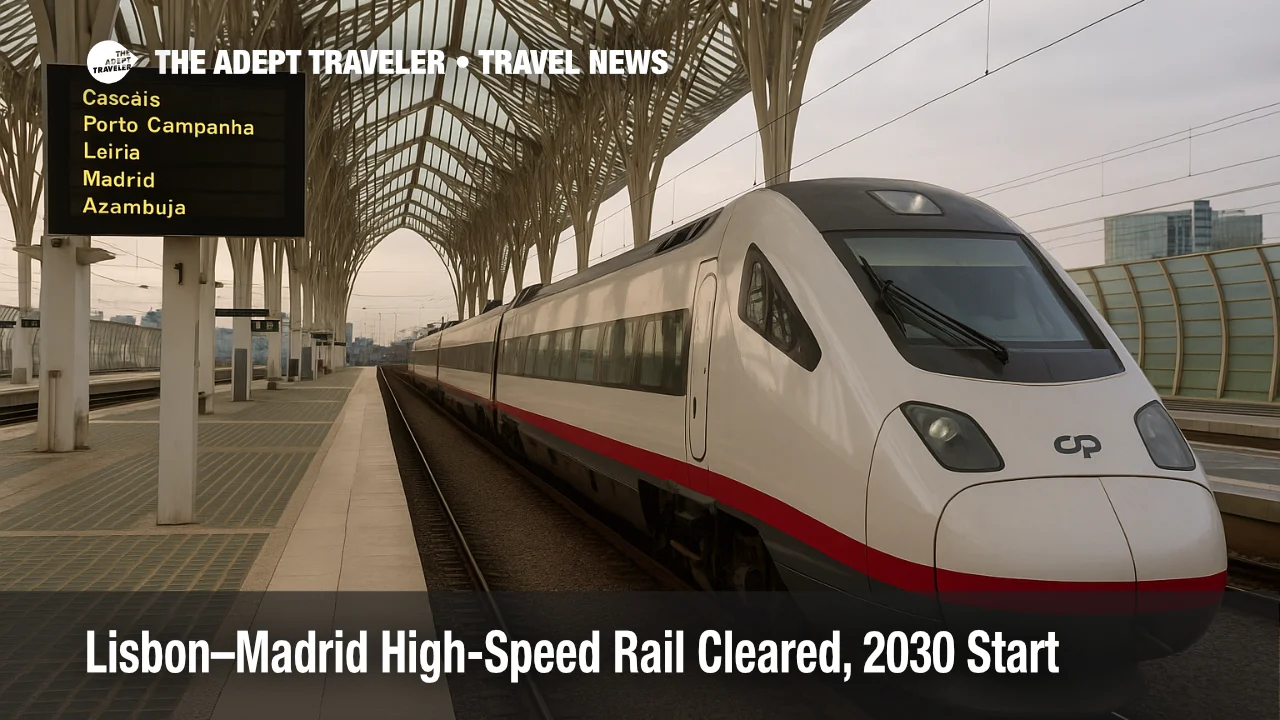Lisbon-Madrid High-Speed Rail Cleared, 2030 Start

Key points
- Portugal, Spain and the European Commission adopted milestones to complete a Lisbon-Madrid link
- Initial five-hour direct service is slated for 2030 with three hours targeted by 2034
- Évora-Caia high-speed section aims to open in 2026, with further Spanish upgrades by 2028-2030
- Plan includes ERTMS rollout and studies on migrating Iberian to standard gauge by 2027
- Project is positioned to shift travelers from short-haul flights to lower-carbon rail
Impact
- Earlier Direct Trains In 2030
- Plan for a roughly five-hour Lisbon-Madrid ride with no changes as cross-border sections open
- Three Hours By 2034
- Target journey time relies on completing the Lisbon-Évora high-speed line and additional upgrades
- Airport Alternative
- Frequent flyers on the route gain a competitive, lower-carbon option versus more than 40 daily flights
- Phased Construction
- Expect interim improvements as Portuguese and Spanish segments come online through 2026-2030
- Standards And Signalling
- ERTMS deployment and gauge-migration studies aim to improve speed, safety and interoperability
Portugal, Spain, and the European Commission have agreed on a concrete roadmap to deliver a new rail link between Lisbon, Portugal, and Madrid, Spain. Officials say a direct service of about five hours is planned by 2030, with full high-speed operations targeting a three-hour journey by 2034, pending completion of key Portuguese and Spanish sections and signal system upgrades. For travelers, the corridor promises a credible alternative to short-haul flights and a simpler, cross-border journey once phased segments open.
What is changing
An implementing decision adopted by the European Commission sets milestones and deadlines to complete the cross-border high-speed connection. The plan sequences Portuguese works on the South International Corridor and Spanish upgrades on the Madrid-Extremadura axis so that a through service can begin around 2030, then accelerate after further infrastructure and systems come online by 2034.
Latest developments
On the Portuguese side, the Évora-Caia high-speed section is scheduled to finish construction in 2025 and enter service in 2026. In Spain, the Plasencia-Talayuela section is due by 2028, with the wider Madrid-Extremadura program progressing toward a 2030 timeframe. Authorities also called out a second track between Poceirão and Bombel by 2029, plus studies for a new Lisbon-Évora high-speed line and a new Tagus crossing, to be completed by 2027.
How it works
The corridor's performance depends on three pillars. First, infrastructure speed, including new-build high-speed alignments in Portugal and upgrades in Spain. Second, cross-border interoperability, with European Rail Traffic Management System (ERTMS) deployment on key stretches to raise speeds and capacity. Third, track-gauge policy, where Portugal and Spain will assess costs, benefits, and interoperability impacts of migrating from the Iberian gauge to the European standard gauge by 2027. Together, these measures enable the move from an initial five-hour direct service to a three-hour target by 2034.
Context and progress to date
Spain has invested heavily in the Madrid-Extremadura corridor, including electrification and high-speed testing between Plasencia and Badajoz, while planning advances on the more complex approach from Oropesa to Madrid. Regional testing at up to 300 km/h and additional tenders indicate steady but phased progress toward a full high-speed link by decade's end. The European Commission notes that coordinated milestones are now in place to bring the cross-border service to life.
Why it matters for travelers
Today, more than 40 daily flights connect the two capitals. A reliable, time-competitive rail alternative can simplify trips, reduce airport time, and cut emissions per passenger. The staged approach means improvements should arrive before 2030, with a single-seat ride and faster times following as infrastructure is commissioned. If you plan frequent travel between Lisbon and Madrid from 2026 onward, monitor opening dates for the Évora-Caia section and subsequent Spanish segments to optimize timing and ticketing.
Final thoughts
The Lisbon-Madrid high-speed rail plan moves from aspiration to a dated, milestone-driven program. If construction and systems integration hold to schedule, travelers could see a five-hour direct train by 2030 and a three-hour benchmark by 2034, bringing Portugal more fully into Europe's high-speed network.
Sources
- European Commission: Commission adopts plan to complete Madrid-Lisbon high-speed connection by 2034
- Euronews: Five-hour Lisbon-Madrid rail link to go ahead by 2030, officials say
- El País: Extremadura realiza pruebas del AVE a 300 km/h
- Canal Extremadura: La Comisión Europea fija plazos para completar el AVE Madrid-Lisboa, cinco horas en 2030 y tres en 2034
- Railway Pro: Contracts awarded for second section of Madrid-Extremadura HSL
- Railtech: Spain, Portugal commit to Madrid-Lisbon HS line by 2030
- Government of Portugal: Government moves forward high-speed rail to Vigo and Madrid
